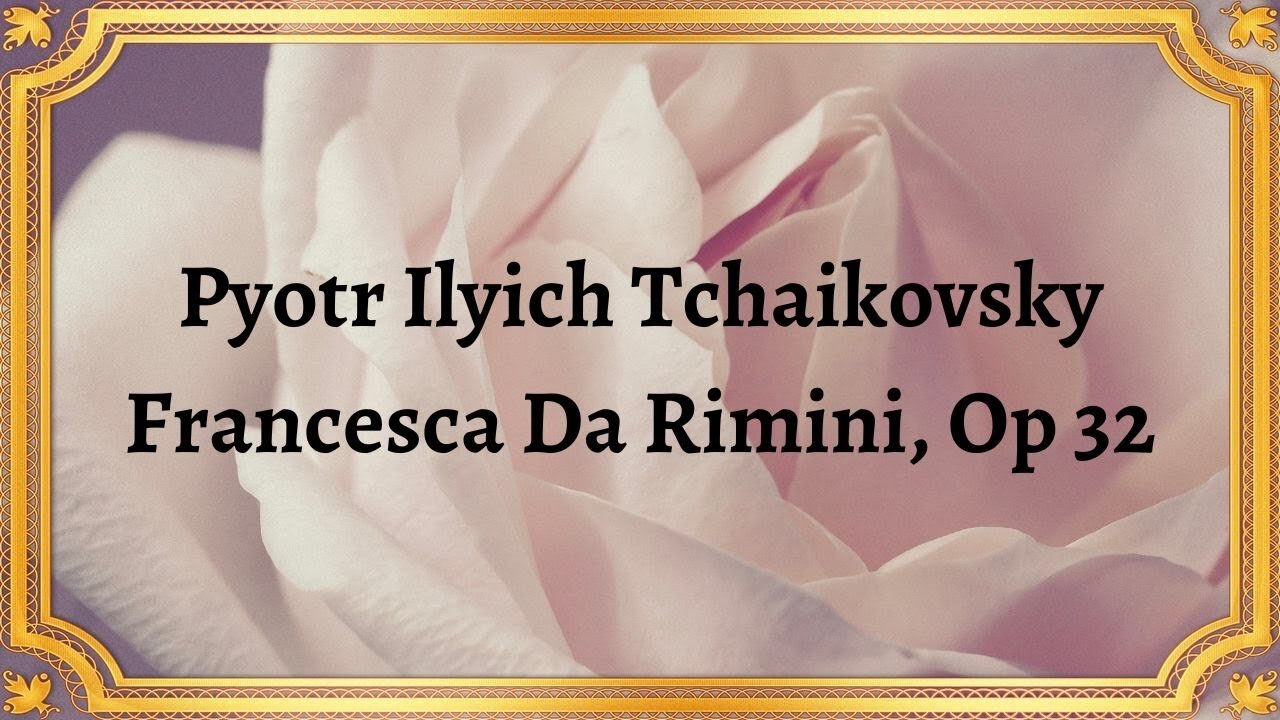Premium Only Content

Pyotr Ilyich Tchaikovsky Francesca Da Rimini, Op 32
#Tchaikovsky #FrancescadaRimini #Op32 #classicalmusic #musicalcomposition #Russiancomposer #symphonicpoem #tragiclovestory #DantesDivineComedy #romanticperiod #orchestralmasterpiece #emotionalintensity #dramaticnarrative #virtuosicorchestration #melodicrichness #musicperformance #musicappreciation #composer #musictheory Pyotr Ilyich Tchaikovsky's
Pyotr Ilyich Tchaikovsky's "Francesca da Rimini, Op. 32" is a captivating musical composition that holds a prominent place in the classical music repertoire. Composed during the romantic period, this symphonic poem tells a tragic love story inspired by Dante's Divine Comedy. With its emotional intensity, dramatic narrative, and virtuosic orchestration, "Francesca da Rimini" stands as a testament to Tchaikovsky's musical genius and his ability to evoke powerful emotions through his compositions.
Tchaikovsky, a renowned Russian composer, created "Francesca da Rimini" in 1876. The piece is based on the story of Francesca da Rimini, a character from Dante's Inferno. The narrative revolves around Francesca's ill-fated love affair with her brother-in-law Paolo, which ultimately leads to their tragic demise. Tchaikovsky's symphonic poem serves as a musical representation of this tragic love story, capturing the emotional turmoil and dramatic tension of the narrative.
The composition begins with a hauntingly beautiful melody, symbolizing the initial attraction and blossoming love between Francesca and Paolo. As the piece progresses, Tchaikovsky skillfully weaves melodic motifs and harmonic progressions to depict the complex emotions and conflicts faced by the doomed lovers. The music shifts seamlessly between passages of melancholy, longing, and intense emotional outbursts, reflecting the turmoil in their relationship.
One of the most remarkable aspects of "Francesca da Rimini" is Tchaikovsky's masterful orchestration. He harnesses the full power and expressiveness of the orchestra to create a rich and dynamic musical landscape. The symphonic poem features a wide range of instruments, including strings, woodwinds, brass, and percussion, each playing a crucial role in conveying the emotions and moods of the narrative. Tchaikovsky's expert handling of dynamics, textures, and instrumental combinations adds depth and color to the composition, enhancing the overall emotional impact.
Throughout "Francesca da Rimini," Tchaikovsky employs various musical techniques to heighten the dramatic tension and intensify the emotional impact. The use of chromatic harmonies, dissonances, and sudden shifts in dynamics creates a sense of unease and turmoil, mirroring the tragic fate of the lovers. Tchaikovsky's melodic inventiveness and the seamless integration of thematic material further contribute to the piece's emotional resonance and musical cohesion.
"Francesca da Rimini" stands as a testament to Tchaikovsky's ability to infuse his compositions with deep emotional and narrative depth. The symphonic poem's tragic storyline, combined with Tchaikovsky's expressive musical language, makes it a captivating and emotionally charged work. It continues to be performed and admired by audiences worldwide, showcasing Tchaikovsky's enduring legacy as one of the most influential composers of the romantic period.
In conclusion, "Francesca da Rimini, Op. 32" by Pyotr Ilyich Tchaikovsky is a remarkable musical composition that brings to life a tragic love story. Through its emotional intensity, dramatic narrative, and virtuosic orchestration, Tchaikovsky's symphonic poem captures the essence of Francesca and Paolo's ill-fated romance. The evocative melodies, skillful orchestration, and use of musical techniques make "Francesca da Rimini" a powerful and enduring work that continues to captivate audiences with its emotional depth and musical brilliance.
You have the opportunity to support the channel https://destream.net/live/RadSiarAl/donate
-
![ROSEANNE BARR - Her Journey, TRUMP, and the MAGA GOLDEN AGE! [INTERVIEW]](https://1a-1791.com/video/s8/1/M/m/B/2/MmB2v.0kob.1-small-ROSEANNE-BARR-Her-Journey-T.jpg) 51:35
51:35
Dr Steve Turley
1 day ago $11.75 earnedROSEANNE BARR - Her Journey, TRUMP, and the MAGA GOLDEN AGE! [INTERVIEW]
28.3K40 -
 57:38
57:38
The Tom Renz Show
4 hours agoMerry Christmas - The Tom Renz Show Christmas
46.2K8 -
 2:59:10
2:59:10
Wendy Bell Radio
14 hours agoThe Bridge Too Far
136K192 -
 1:03:45
1:03:45
Donald Trump Jr.
1 day agoHappy Festivus: Airing Our Grievances and Stopping The Swamp w/Sean Davis | TRIGGERED Ep.201
404K524 -
 1:30:30
1:30:30
Game On!
17 hours ago $7.48 earnedTop 5 things you need to know for Sports Christmas!
59.3K4 -
 1:58:10
1:58:10
Robert Gouveia
1 day agoMatt Gaetz REJECTS Report, Sues Committee; Luigi Fan Club Arrives; Biden Commutes; Festivus Waste
284K224 -
 1:31:40
1:31:40
Adam Does Movies
1 day ago $15.68 earnedThe Best & Worst Christmas Movies! - LIVE!
109K8 -
 58:10
58:10
Kimberly Guilfoyle
1 day agoAmerica is Back & The Future is Bright: A Year in Review | Ep. 183
198K74 -
 3:03:27
3:03:27
vivafrei
1 day agoEp. 242: Barnes is BACK AGAIN! Trump, Fani, J6, RFK, Chip Roy, USS Liberty AND MORE! Viva & Barnes
270K256 -
 2:05:48
2:05:48
2 MIKES LIVE
10 hours agoTHE MIKE SCHWARTZ SHOW with DR. MICHAEL J SCHWARTZ 12-24-2024
41.4K5